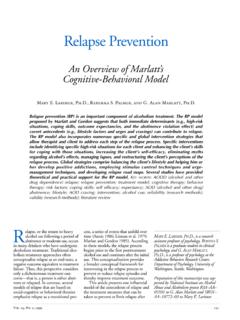Transcription of }Pv] À Z µ µ ]vP - talkplus.org.uk
1 Cog iive Restructuri g cognitive restructuring cognitive restructuring is an evidence based intervention for the treatment of low mood or anxiety, recommended by the National Institute for Health and Clinical Excellence (NIHCE, 2009). This workbook can be used either alone or with the support of your Psychological Wellbeing Practitioner. How to use this workbook. cognitive restructuring has three steps. It is important to work through one step at a time, only move on to the next step of cognitive restructuring once you are comfortable with using the previous step.
2 It is key to follow all three steps of cognitive restructuring in sequence. It can take some time for an intervention to become effective and to show improvement. It is important to allow enough time for the effects of cognitive restructuring to be effective. Evidence of Effectiveness;. Helpful Resources;. A Recovery Programme for Depression, by Lovell and Richards Realistic thinking Challenging Unhelpful Thoughts ABC Analysis and Detective Work & Disputation Mind Over Mood, by Greenberg and Padesky cognitive restructuring Challenging Unhelpful Thoughts cognitive restructuring is an evidence based treatment used to challenge unhelpful thoughts in low mood or anxiety.
3 It works by identifying negative or unhelpful thoughts and gathering evidence to the accuracy of the thought. This evidence then helps us to develop a more realistic and helpful thought. Man is troubled, not by events, but by the meaning he gives to them ~ Epictetus (55-135AD). Our thoughts can have a big impact on the way we feel, when we feel low or anxious we may find this is, in part, due to having negative or unhelpful thoughts. By challenging these thoughts and developing more helpful and realistic thoughts we can help improve our mood.
4 Helpful and realistic thinking is neither negative or positive, it takes all perspectives into account. This would mean looking at yourself, others, and the world in a balanced and fair way. The Vicious Cycle of Unhelpful Thinking When we have a negative or unhelpful thought about a specific situation, ourselves, other people or the world it can make us feel low or anxious. Our thoughts tend to focus mainly on the threat or current problem when we are low or anxious, this is called a negative bias. This can impair our ability to take into account other perspectives.
5 In this way, negative or unhelpful thinking can maintain the way we are feeling. STEP ONE. Identifying Unhelpful Thoughts The first step of cognitive restructuring is to identify unhelpful thoughts that are causing us distress. We then record these captured thoughts into a Thought Diary along with the situation we had the thought in, how much we believe the thought and how it made us feel. Initially it may be difficult to capture our thoughts as it is not something we do in our day to day lives. By using the technique below we can begin to capture the thoughts that are causing us to feel low or anxious.
6 When you notice you are feeling low or anxious;. Stop Stop what you are doing and take a moment. Time to breathe Pay attention to your breathing. Overview Ask yourself some questions to get an overview of what is happening. Perspective Record the thought going through your mind to get a better perspective. Some useful questions to help identify your unhelpful thoughts are;. What am I telling myself right now? . What is making me feel this way? . What bad thing am I predicting will happen? . The Thought Diary on Worksheet 1 contains a number of columns to help us understand the context and impact of the thought, as well as getting us to consider how much we believe the thought to be true.
7 Often the more that we believe the thought to be true the higher the distress it can cause. Therefore recording all this information not only allows us to better understand the thought but allows us to begin to get a difference perspective. When you notice that you are feeling low or anxious use the STOP' technique above to help capture any unhelpful thoughts that may be in your mind. Using Worksheet 1 record the situation you were in, the thought or thoughts you had at that time and the emotion you were experiencing. The last two columns are to record how much you believe the thought to be true (from 0-100%) and the intensity of the emotion you were experiencing.
8 Sometimes the thoughts we identify can be in the form of questions, in this case it is important to answer the question to understand what we are predicting will cause us distress. For example; What if I don't meet my deadline at work , the answer might be If I don't meet my deadline I will be sacked , this negative outcome is what causes us to feel distressed. It is best to record the thought as soon as possible as then we can accurately say how much we believed it to be true at the time. Sometimes this may not be possible, for example if at work or out, however a phone or notepad can be used to jot down the thought until we can next use the worksheet.
9 To complete Step 1 use Worksheet 1. Fill in the worksheet with the situation, thought, belief and emotion. WORKSHEET ONE. Thought Diary Belief i thought I te sity of e oio Situaio Thought E oio - % - %. STEP TWO. Gathering Evidence The second step of cognitive restructuring is choose a thought from Worksheet 1 that causes the most intense emotion to challenge. This step involves gathering evidence for and against the accuracy of your chosen thought, much like in a court case. By gathering evidence both for and against the thought we are able to assess whether the thought is realistic or helpful.
10 Worksheet 2 allows us to put our thought on trial, as in a court case, gathering evidence that backs up the thought (evidence for) and evidence that disproves the thought (evidence against). As in a court of law, it is important to include only factual evidence and not our own opinions or feelings. Often the intensity of our emotion increases our belief in the thought, however it is often the thought itself that causes the emotion we feel. It may be difficult to decide on a thought to gather evidence for and against, it is important that we try to choose a thought that caused us the most intense distress.









